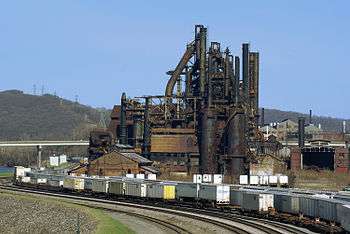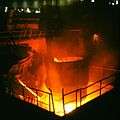Steelmaking
Steelmaking is the process of producing steel from iron ore and/or scrap. In steelmaking, impurities such as nitrogen, silicon, phosphorus, sulfur and excess carbon (most important impurity) are removed from the sourced iron, and alloying elements such as manganese, nickel, chromium, carbon and vanadium are added to produce different grades of steel. Limiting dissolved gases such as nitrogen and oxygen and entrained impurities (termed "inclusions") in the steel is also important to ensure the quality of the products cast from the liquid steel.[1]

Steelmaking has existed for millennia, but it was not commercialized on a massive scale until the late 19th century. An ancient process of steelmaking was the crucible process. In the 1850s and 1860s, the Bessemer process and the Siemens-Martin process turned steelmaking into a heavy industry. Today there are two major commercial processes for making steel, namely basic oxygen steelmaking, which has liquid pig-iron from the blast furnace and scrap steel as the main feed materials, and electric arc furnace (EAF) steelmaking, which uses scrap steel or direct reduced iron (DRI) as the main feed materials. Oxygen steelmaking is fuelled predominantly by the exothermic nature of the reactions inside the vessel; in contrast, in EAF steelmaking, electrical energy is used to melt the solid scrap and/or DRI materials. In recent times, EAF steelmaking technology has evolved closer to oxygen steelmaking as more chemical energy is introduced into the process.[2]
History

Steelmaking has played a crucial role in the development of ancient, medieval, and modern technological societies. Early processes of steel making were made during the classical era in Ancient Iran, Ancient China, India, and Rome but the process of ancient steelmaking was lost in the West after the fall of the Western Roman Empire in the 5th century CE.[3]
Cast iron is a hard, brittle material that is difficult to work, whereas steel is malleable, relatively easily formed and a versatile material. For much of human history, steel has only been made in small quantities. Since the invention of the Bessemer process in the 19th century and subsequent technological developments in injection technology and process control, mass production of steel has become an integral part of the global economy and a key indicator of modern technological development.[4] The earliest means of producing steel was in a bloomery.
Early modern methods of producing steel were often labour-intensive and highly skilled arts. See:
- finery forge, in which the German finery process could be managed to produce steel.
- blister steel and crucible steel.
An important aspect of the Industrial Revolution was the development of large-scale methods of producing forgeable metal (bar iron or steel). The puddling furnace was initially a means of producing wrought iron but was later applied to steel production.
The real revolution in modern steelmaking only began at the end of the 1850s when the Bessemer process became the first successful method of steelmaking in high quantity followed by the open-hearth furnace.
Modern processes
Modern steelmaking processes can be divided into two categories: primary and secondary.
Primary steelmaking involves converting liquid iron from a blast furnace and steel scrap into steel via basic oxygen steelmaking, or melting scrap steel or direct reduced iron (DRI) in an electric arc furnace.
Secondary steelmaking involves refining of the crude steel before casting and the various operations are normally carried out in ladles. In secondary metallurgy, alloying agents are added, dissolved gases in the steel are lowered, and inclusions are removed or altered chemically to ensure that high-quality steel is produced after casting.[5]
Primary steelmaking
Basic oxygen steelmaking is a method of primary steelmaking in which carbon-rich molten pig iron is converted into steel. Blowing oxygen through molten pig iron lowers the carbon content of the alloy and changes it into steel. The process is known as basic due to the chemical nature of the refractories—calcium oxide and magnesium oxide—that line the vessel to withstand the high temperature and corrosive nature of the molten metal and slag in the vessel. The slag chemistry of the process is also controlled to ensure that impurities such as silicon and phosphorus are removed from the metal.
The process was developed in 1948 by Robert Durrer, using a refinement of the Bessemer converter where blowing of air is replaced with blowing oxygen. It reduced the capital cost of the plants and the time of smelting, and increased labor productivity. Between 1920 and 2000, labour requirements in the industry decreased by a factor of 1000, from more than 3 man-hours per tonne to just 0.003 man-hours. The vast majority of steel manufactured in the world is produced using the basic oxygen furnace; in 2011, it accounted for 70% of global steel output. Modern furnaces will take a charge of iron of up to 350 tons and convert it into steel in less than 40 minutes compared to 10–12 hours in an open hearth furnace.[6]
Electric arc furnace steelmaking is the manufacture of steel from scrap or direct reduced iron melted by electric arcs. In an electric arc furnace, a batch of steel ("heat") may be started by loading scrap or direct reduced iron into the furnace, sometimes with a "hot heel" (molten steel from a previous heat). Gas burners may be used to assist with the melt down of the scrap pile in the furnace. As in basic oxygen steelmaking, fluxes are also added to protect the lining of the vessel and help improve the removal of impurities. Electric arc furnace steelmaking typically uses furnaces of capacity around 100 tonnes that produce steel every 40 to 50 minutes for further processing.[6]
Secondary steelmaking
Secondary steelmaking is most commonly performed in ladles. Some of the operations performed in ladles include de-oxidation (or "killing"), vacuum degassing, alloy addition, inclusion removal, inclusion chemistry modification, de-sulphurisation, and homogenisation. It is now common to perform ladle metallurgical operations in gas-stirred ladles with electric arc heating in the lid of the furnace. Tight control of ladle metallurgy is associated with producing high grades of steel in which the tolerances in chemistry and consistency are narrow.[5]
HIsarna steelmaking
In HIsarna ironmaking process, iron ore is processed almost directly into liquid iron or hot metal. The process is based around a type of blast furnace called a cyclone converter furnace, which makes it possible to skip the process of manufacturing pig iron pellets that is necessary for the basic oxygen steelmaking process. Without the necessity of this preparatory step, the HIsarna process is more energy-efficient and has a lower carbon footprint than traditional steelmaking processes.
See also
References
- Deo, Brahma; Boom, Rob (1993). Fundamentals of Steelmaking Metallurgy. New York: Prentice Hall International. ISBN 9780133453805. LCCN 92038513. OCLC 473115765.
- Turkdogan, E.T. (1996). Fundamentals of Steelmaking. London: Institute of Materials. ISBN 9781907625732. OCLC 701103539.
- Pahl, Ron (2002). Breaking Away from the Textbook: Prehistory to 1600. Scarecrow Press Inc. p. 53. ISBN 978-0810837591.
- Sass, Stephen L. (August 2011). The Substance of Civilization: Materials and Human History from the Stone Age to the Age of Silicon. New York: Arcade Publishing. ISBN 9781611454017. OCLC 1078198918.
- Ghosh, Ahindra. (December 13, 2000). Secondary Steelmaking: Principles and Applications (1st ed.). Boca Raton, Fla.: CRC Press. ISBN 9780849302640. LCCN 00060865. OCLC 664116613.
- Fruehan, Richard J., ed. (1998). The Making, Shaping and Treating of Steel: Steelmaking and Refining Volume (11th ed.). Pittsburgh: AIST. ISBN 978-0-930767-02-0. LCCN 98073477. OCLC 906879016.
External links
- The short film The Drama of Steel (1946) is available for free download at the Internet Archive
- U.S. Steel Gary Works Photograph Collection, 1906–1971
- "Steel For The Tools For Victory" , December 1943, Popular Science large detailed article with numerous illustrations and cutaways on the modern basics of making steel
